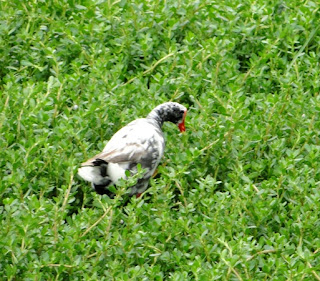White Bali Myna
(Internet Photograph)
This white Bali Myna is so beautiful and it is my favorite species of Myna birds. I have never seen one in "real life", however, I stumbled across it by accident on the internet. All myna (or mynah) birds belong to the starling family, particularly all those called Myna are in the Indian subcontinent.
Below is a video of this endangered bird.
Below are some of my own photographs that I took of the common myna, or Indian myna, here on the island of Oahu, Hawaii.
The common myna with the extra white plumage got my curiosity up so I tried to find information about it on the internet, to no avail. I guess it is a rare case of too much white on this species. At any rate, that is how I discovered the white Bali myna on the web. In 2000 the IUCN Species Survival Commission declared the common myna one of the world's most invasive species. I am not really fond of these birds; they are noisy and have an ugly screech. There was one myna I enjoyed, though, not long after I moved to Hawaii. I first lived in Makiki suburb, which was home to a myna that used to give frequent wolf whistles. I heard it often from where I lived, and it was great to get a wolf whistle from him when I walked down the street ! <Sigh ! Big grin.> I attended a church not too far from my apartment, and one Sunday that whistling myna was interrupting our Sunday School class so much that the preacher's wife also interrupted the study and said something to the effect of "Who taught that bird to whistle?" (It has been several years since that incident so I cannot remember all of her exact words.) The windows were open in our class so we got a good earful. :-)
Below is a video of a talking myna bird. He rather charms me into liking him.
In Hawaii the common or Indian myna is everywhere to be found on all of the islands. It was first introduced from India in 1865 to control the insect population. It is about 9 inches and both the male and female look pretty much alike. When it flies you really notice the white wing patches.
They are very social birds and travel in pairs. They gather in large groups and roost in trees. They breed from February to August and they raise one to three broods a year. They lay two to five eggs in each brood. Incubation time is over 13 days and the babies fledge sometime later between 29 to 35 days.
Below are some photographs from the Internet of other species of Mynas.
White-necked Myna
Brahminy Myna
Sri Lanka Hill Myna


































